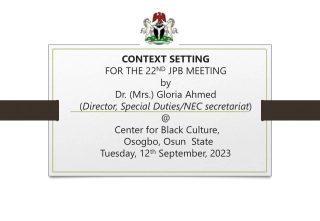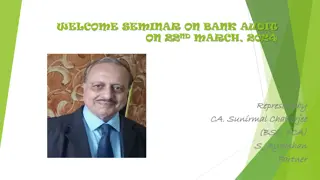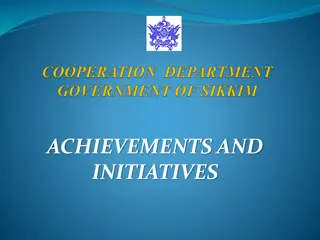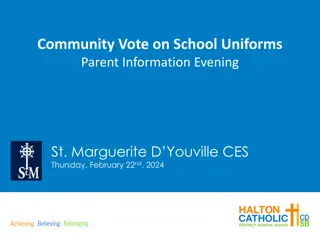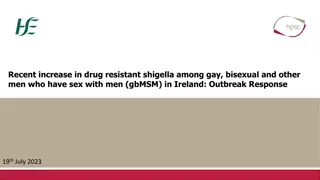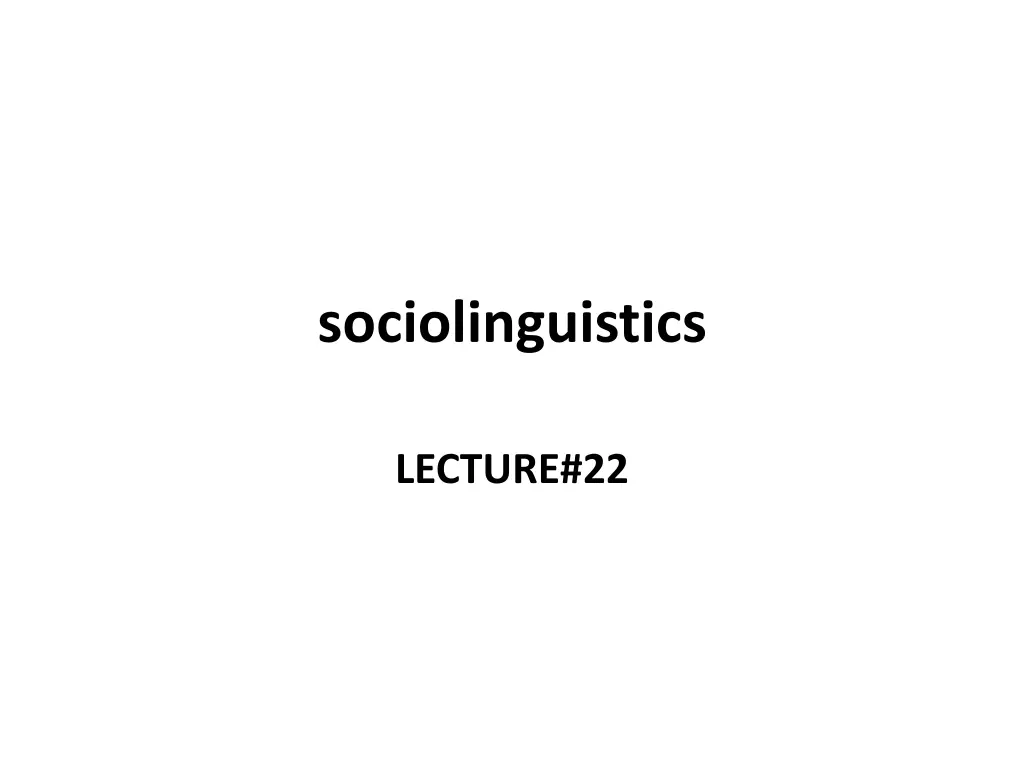
Exploring Relationships Between Language and Society in Sociolinguistics
Delve into the intricate connections between language and society as observed in sociolinguistics. Uncover the various possible relationships where social structure influences linguistic structure and behavior, linguistic structure impacts social structure, or both language and society interact in a bi-directional manner. Understand the significance of correlational studies in sociolinguistic research to identify patterns and changes in the language-society dynamic.
Download Presentation

Please find below an Image/Link to download the presentation.
The content on the website is provided AS IS for your information and personal use only. It may not be sold, licensed, or shared on other websites without obtaining consent from the author. If you encounter any issues during the download, it is possible that the publisher has removed the file from their server.
You are allowed to download the files provided on this website for personal or commercial use, subject to the condition that they are used lawfully. All files are the property of their respective owners.
The content on the website is provided AS IS for your information and personal use only. It may not be sold, licensed, or shared on other websites without obtaining consent from the author.
E N D
Presentation Transcript
sociolinguistics LECTURE#22
Sociolinguistics There are several possible relationships between language and society. One is that social structure may either influence or determine linguistic structure and/or behavior. Certain evidence may be adduced to support this view: the age- grading phenomenon whereby young children speak differently from older children and, in turn, children speak differently from mature adults; studies which show that the varieties of language that speakers use reflect such matters as their regional, social, or ethnic origin and possibly even their gender; and other studies which show that particular ways of speaking, choices of words, and even rules for conversing are in fact highly determined by certain social requirements.
Sociolinguistics A second possible relationship is directly opposed to the first: linguistic structure and/or behavior may either influence or determine social structure. This is the view that is behind the Whorfian hypothesis, the claims of Bernstein, and many of those who argue that languages rather than speakers of these languages can be sexist . A third possible relationship is that the influence is bi-directional: language and society may influence each other.
Sociolinguistics One variant of this approach is that this influence is dialectical in nature, a Marxist view put forward by Dittmar (1976), who argues that speech behaviour and social behaviour are in a state of constant interaction and that material living conditions are an important factor in the relationship.
Sociolinguistics A fourth possibility is to assume that there is no relationship at all between linguistic structure and social structure and that each is independent of the other. A variant of this possibility would be to say that, although there might be some such relationship, present attempts to characterize it are essentially premature, given what we know about both language and society. Actually, this variant view appears to be the one that Chomsky himself holds: he prefers to develop an asocial linguistics as a preliminary to any other kind of linguistics, such an asocial approach being, in his view, logically prior.
Sociolinguistics We must therefore be prepared to look into various aspects of the possible relationships between language and society. It will be quite obvious from doing so that correlational studies must form a significant part of sociolinguistic work. Gumperz (1971) has observed that sociolinguistics is an attempt to find correlations between social structure and linguistic structure and to observe any changes that occur.
Sociolinguistics Chambers (2002) is even more direct: Sociolinguistics is the study of the social uses of language, and the most productive studies in the four decades of sociolinguistic research have emanated from determining the social evaluation of linguistic variants. These are also the areas most susceptible to scientific methods such as hypothesis-formation, logical inference, and statistical testing.
Sociolinguistics However, as Gumperz and others have been quick to indicate, such studies do not exhaust sociolinguistic investigation, nor do they always prove to be as enlightening as one might hope. It is a well-known fact that a correlation shows only a relationship between two variables; it does not show ultimate causation. To find that X and Y are related is not necessarily to discover that X causes Y (or Y causes X), for it is also quite possible that some third factor, Z, may cause both X and Y (or even that some far more subtle combination of factors is involved). We must always exercise caution when we attempt to draw conclusions from such relationships.
Sociolinguistics A worthwhile sociolinguistics, however, must be something more than just a simple mixing of linguistics and sociology which takes concepts and findings from the two disciplines and attempts to relate them in simple ways. It certainly must go beyond Horvath s view (1998) that sociolinguists should just pick and choose freely from sociology: What my kind of sociolinguists do is go periodically to sociology and find social networks or the linguistic market place . . . and we find [these concepts] terribly useful in understanding the patterns that emerge from our data.
Sociolinguistics However, we are not engaged in the sociologists struggles over the importance of social networks vis- -vis other ways of dealing with the structure of society and may remain blissfully unaware of whether or not these models have become contentious within the home discipline. A serious scientific approach is incompatible with blissful unawareness in an essential part of its underpinnings. Hymes (1974) has pointed out that even a mechanical amalgamation of standard linguistics and standard sociology is not likely to suffice in that in adding a speechless sociology to a sociology-free linguistics we may miss what is important in the relationship between language and society.
Sociolinguistics Specific points of connection between language and society must be discovered, and these must be related within theories that throw light on how linguistic and social structures interact. Holmes (1992) says that the sociolinguist s aim is to move towards a theory which provides a motivated account of the way language is used in a community, and of the choices people make when they use language. For example, when we observe how varied language use is we must search for the causes.
Sociolinguistics Upon observing variability, we seek its social correlates. What is the purpose of the variation? How is it evaluated in the community? What do its variants symbolize? (Chambers, 2003). For Chambers these questions are the central questions of sociolinguistics. Chambers is not alone in holding such views. Others too believe that sociolinguistics is the study of language variation and that the purpose of such study is to find out what variation tells us about language and speakers knowledge of language, in this case their unconscious knowledge of subtle linguistic differences.
Sociolinguistics We will also see that there is some opposition to this idea that sociolinguistic investigations should be confined to fairly straightforward correlational studies of this kind. Critics such as Cameron (1997) claim that these studies do not provide very satisfactory explanations for linguistic behavior because of inadequacies with social theory sometimes there is none at all and failure to appreciate the difficulties in using social concepts Any conclusions are likely to be suspect. What is needed, according to Cameron, is more social engagement so that sociolinguistics would deal with such matters as the production and reproduction of linguistic norms by institutions and socializing practices; how these norms are apprehended, accepted, resisted and subverted by individual actors and what their relation is to the construction of identity. Milroy (2001) makes a somewhat similar claim in discussing the processes of standardization and change: Social patterns are adduced only in so far as they may elucidate patterns of language by exhibiting co-variation with linguistic variables . . . and as long as internal analyses are quite strongly biased in favor of linguistic, rather than social, phenomena, the quantitative paradigm will be to that extent impeded in its attempts to explain the social life of language and the social origins of language change
Sociolinguistics . I have already mentioned this idea of necessary social engagement and I will return to it later. However, one point is clear in the above disagreement: sociolinguistics, whatever it is, is about asking important questions concerning the relationship of language to society. In the pages that follow I will try to show you some of those questions.
Sociolinguistics Discussion 1. To convince yourself that there are some real issues here with regard to the possible relationships between language and society, consider your responses to the following questions and compare them with those of others. a. Does an Inuit see a snowscape differently from a native of Chad visiting the cold north for the first time because the Inuit must be using a language developed to deal with the surrounding snowscape? b. If men and women speak differently, is it because the common language they share has a gender bias, because boys and girls are brought up differently, or because part of gender marking is the linguistic choices one can indeed, must make?
Sociolinguistics Is language just another cultural artifact, like property, possessions, or money, which is used for the expression of power and/or as a medium of exchange? d. If language is an essential human attribute and humans are necessarily social beings, what problems and paradoxes do you see for theoretical work in sociolinguistics if the latter is to grapple with the relationships between linguistic and social factors?
Sociolinguistics 2. One aspect of the power of professionals is said to be the way they are able to use language to control others. How do physicians, psychiatrists, lawyers, social workers, teachers, priests, police officers, etc. use language to control others? Does this same power principle apply to parents (in relation to children), men (in relation to women), upper social classes (in relation to lower social classes), speakers of standard languages (in relation to speakers of nonstandard varieties of those languages), and so on?
Sociolinguistics and the Sociology of Language Some investigators have found it appropriate to try to introduce a distinction between sociolinguistics or micro- sociolinguistics and the sociology of language or macro- sociolinguistics. In this distinction, sociolinguistics is concerned with investigating the relationships between language and society with the goal being a better understanding of the structure of language and of how languages function in communication; the equivalent goal in the sociology of language is trying to discover how social structure can be better understood through the study of language, e.g., how certain linguistic features serve to characterize particular social arrangements.
Sociolinguistics Hudson (1996) has described the difference as follows: sociolinguistics is the study of language in relation to society, whereas the sociology of language is the study of society in relation to language. In other words, in sociolinguistics we study language and society in order to find out as much as we can about what kind of thing language is, and in the sociology of language we reverse the direction of our interest.
Sociolinguistics Using the alternative terms given above, Coulmas (1997) says that micro-sociolinguistics investigates how social structure influences the way people talk and how language varieties and patterns of use correlate with social attributes such as class, sex, and age. Macro-sociolinguistics, on the other hand, studies what societies do with their languages, that is, attitudes and attachments that account for the functional distribution of speech forms in society, language shift, maintenance, and replacement, the delimitation and interaction of speech communities.
Sociolinguistics The view I will take here is that both sociolinguistics and the sociology of language require a systematic study of language and society if they are to be successful. Moreover, a sociolinguistics that deliberately refrains from drawing conclusions about society seems to be unnecessarily restrictive, just as restrictive indeed as a sociology of language that deliberately ignores discoveries about language made in the course of sociological research. So while it is possible to do either kind of work to the exclusion of the other, I will be concerned with looking at both kinds. My own views are essentially in agreement with those of Coulmas (1997), expressed as follows:
Sociolinguistics There is no sharp dividing line between the two, but a large area of common concern. Although sociolinguistic research centers about a number of different key issues, any rigid micro macro compartmentalization seems quite contrived and unnecessary in the present state of knowledge about the complex interrelationships between linguistic and social structures. Contributions to a better understanding of language as a necessary condition and product of social life will continue to come from both quarters.
Sociolinguistics Consequently, I will not attempt to make the kinds of distinctions found in Trudgill (1978). He tries to differentiate those studies that he considers to be clearly sociolinguistic in nature from those that clearly are not, for, as he says, while everybody would agree that sociolinguistics has something to do with language and society, it is clearly also not concerned with everything that could be considered language and society .
Sociolinguistics The problem, therefore, lies in the drawing of the line between language and society and sociolinguistics. Different scholars draw the line in different places. Trudgill argues that certain types of language studies are almost entirely sociological in their objectives and seem to fall outside even the sociology of language. Included in this category are ethnomethodological studies and work by such people as Bernstein. For Trudgill, such work is definitely not sociolinguistics, however defined, since it apparently has no linguistic objectives.
Sociolinguistics According to Trudgill, certain kinds of work combine insights from sociology and linguistics. Examples of such work are attempts to deal with the structure of discourse and conversation, speech acts, studies in the ethnography of speaking , investigations of such matters as kinship systems, studies in the sociology of language, e.g., bilingualism, code-switching, and diglossia, and certain practical concerns such as various aspects of teaching and language behavior in classrooms.
Sociolinguistics While Trudgill considers all such topics to be genuinely sociolinguistic, he prefers, however, to use that term in a rather different and somewhat narrower sense. Elsewhere (1995), he says that such concerns are perhaps better subsumed under anthropological linguistics, geolinguistics, the social psychology of language, and so on.
Sociolinguistics For Trudgill there is still another category of studies in which investigators show a concern for both linguistic and social matters. This category consists of studies which have a linguistic intent. Studies of this type are based on empirical work on language as it is spoken in its social context, and are intended to answer questions and deal with topics of central interest to linguists (1978). These studies are just another way of doing linguistics. Included in this category are studies of variation and linguistic change, and the seminal figure is Labov.
Sociolinguistics According to Trudgill, Labov has addressed himself to issues such as the relationship between language and social class, with his main objective not to learn more about a particular society or to examine correlations between linguistic and social phenomena, but to learn more about language and to investigate topics such as the mechanisms of linguistic change, the nature of linguistic variability, and the structure of linguistic systems.
Sociolinguistics Trudgill s view is that all work in this category is aimed ultimately at improving linguistic theory and at developing our understanding of the nature of language (1978). For him this is genuine sociolinguistics. Chambers (2002, 2003) voices a similar view and Downes (1998) echoes it: sociolinguistics is that branch of linguistics which studies just those properties of language and languages which require reference to social, including contextual, factors in their explanation.
Sociolinguistics However, in reviewing research on language and society, Downes reach far exceeds that of Trudgill, even that of his glossary of terms (2003), where he characterizes sociolinguistic research as work which is intended to achieve a better understanding of the nature of human language by studying language in its social context and/or to achieve a better understanding of the nature of the relationship and interaction between language and society.
Sociolinguistics (A word of warning may be in order. Trudgill, Chambers, Downes, and I and many others we will come across approach sociolinguistics from a background in linguistics rather than in sociology or psychology, or feminist studies, or . . . Readers should always keep that fact in mind when assessing what we say.)
Sociolinguistics As I have already indicated in referring earlier to Cameron s views (1997), there is also a growing amount of work within a broadly defined sociolinguistics that takes what I will call an interventionist approach to matters that interest us. This work has been called linguistics with a conscience and a cause, one which seeks to reveal how language is used and abused in the exercise of power and the suppression of human rights (Widdowson, 1998). Two of its main exponents are Fairclough (1995, 2001) and van Dijk (1993), who champion an approach called critical discourse analysis.
Sociolinguistics This work focuses on how language is used to exercise and preserve power and privilege in society, how it buttresses social institutions, and how even those who suffer as a consequence fail to realize how many things that appear to be natural and normal are not at all so. They are not so because it is power relations in society that determine who gets to say what and who gets to write what. The claim is that politics, medicine, religion, eduation, law, race, gender, and academia can only be understood for what they really are within the framework of critical discourse analysis: as systems that maintain an unequal distribution of wealth, income, status, group membership, education, and so on. Fairclough (2001) expresses what he sees as the failure of sociolinguistics to deal with such matters as follows:
Sociolinguistics Sociolinguistics is strong on what? questions (what are the facts of variation?) but weak on why? and how? questions (why are the facts as they are?; how in terms of the development of social relationships of power was the existing sociolinguistic order brought into being?; how is it sustained?; and how might it be changed to the advantage of those who are dominated by it?).
Sociolinguistics This is very much an ideological view. Its proponents maintain that all language use is ideological as are all investigations, i.e., that there is no hope of an objective or neutral sociolinguistics. Consequently, critical discourse analysis is ideological and judgmental. It claims the high ground on issues; it is a resource for people who are struggling against domination and oppression in its linguistic forms (Fairclough, 1995). We might well exercise caution in assessing any claims we find: appeals to what is right tend to short-circuit genuine scientific inquiry. In chapters 13 15 we will see examples of sociolinguistic studies which are definitely interventionist in approach.
Sociolinguistics Discussion 1. Ethnomethodology is the study of commonsense knowledge and practical reasoning. To convince yourself that you have such knowledge and do employ such reasoning, see what happens if you react literally when someone next addresses you with such formulaic expressions as How do you do? or Have a nice day. For example, you can respond What do you mean, How do I do? or How do you define a nice day ? (Be careful!) You should find that commonsense knowledge tells you not to take everything you hear literally. So far as practical reasoning is concerned, collect examples of how people actually do reach conclusions, give directions, and relate actions to consequences or causes to effects. Do they do this in any scientific manner?
Sociolinguistics Bernstein, a British sociologist, has claimed that some children acquire a somewhat limited exposure to the full range of language use as a result of their upbringing, and may consequently be penalized in school. What kinds of evidence would you consider to be relevant to confirming (or disconfirming) such a claim? 3. Conversations are not simple matters. What can you say about each of the conversations that follow? Do you see anything you might call structural in some that you do not see in others? How, in particular, does the last fail ? a. A. Excuse me! B. Yes. A. Gotta match? B. Sorry! A. Thanks. b. A. Gotta match? B. Nope? c. A. Excuse me, gotta match? B. Yes. (offer) A. (silence)
Sociolinguistics 4. Labov (1970) has described the sociology of language as follows: It deals with large-scale social factors, and their mutual interaction with languages and dialects. There are many open questions, and many practical problems associated with the decay and assimilation of minority languages, the development of stable bilingualism, the standardization of languages and the planning of language development in newly emerging nations. The linguistic input for such studies is primarily that a given person or group uses language X in a social context or domain Y. What are some of the questions and problems you see in your society, either broadly or narrowly defined, that fall within such a sociology of language?
Sociolinguistics 5. As a further instance of a topic that might be covered in the sociology of language, consider who speaks English in the world, where, and for what purposes? You might also contrast what you can find out about the uses of English with what you can find out about the uses of Latin, Swahili, French, Haitian Creole, Basque, and Esperanto.
Sociolinguistics 6. Studies of linguistic variation make use of the concept of the linguistic variable. One simple linguistic variable in English is the pronunciation of the final sound in words like singing, running, fishing, and going (-ing or -in ) in contexts such as He was singing in the rain, Running is fun, It s a fishing boat, and Are you going? and on various occasions (e.g., in casual conversation, in formal speech making, or in reading individual words out aloud). What do you find? How might you try to explain any differences you find?
Methodological Concerns Sociolinguistics should encompass everything from considering who speaks (or writes) what language (or what language variety) to whom and when and to what end (Fishman, 1972b), that is, the social distribution of linguistic items, to considering how a particular linguistic variable might relate to the formulation of a specific grammatical rule in a particular language or dialect, and even to the processes through which languages change. Whatever sociolinguistics is, it must be oriented toward both data and theory: that is, any conclusions we come to must be solidly based on evidence.
Sociolinguistics Above all, our research must be motivated by questions that can be answered in an approved scientific way. Data collected for the sake of collecting data are of little interest, since without some kind of focus that is, without some kind of non-trivial motive for collection they can tell us little or nothing. A set of random observations about how a few people we happen to observe use language cannot lead us to any useful generalizations about behavior, either linguistic or social.

